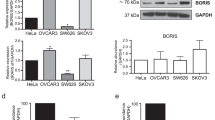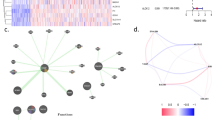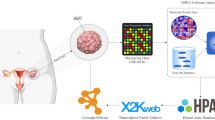Abstract
Epidemiological studies have implicated androgens in the etiology and progression of epithelial ovarian cancer. We previously reported that some androgen responses were dysregulated in malignant ovarian epithelial cells relative to control, non-malignant ovarian surface epithelial (OSE) cells. Moreover, dysregulated androgen responses were observed in OSE cells derived from patients with germline BRCA-1 or -2 mutations (OSEb), which account for the majority of familial ovarian cancer predisposition, and such altered responses may be involved in ovarian carcinogenesis or progression. In the present study, gene expression profiling using cDNA microarrays identified 17 genes differentially expressed in response to continuous androgen exposure in OSEb cells and ovarian cancer cells as compared to OSE cells derived from control patients. A subset of these differentially affected genes was selected and verified by quantitative real-time reverse transcription–polymerase chain reaction. Six of the gene products mapped to the OPHID protein–protein interaction database, and five were networked within two interacting partners. Basic leucine zipper transcription factor 2 (BACH2) and acetylcholinesterase (ACHE), which were upregulated by androgen in OSEb cells relative to OSE cells, were further investigated using an ovarian cancer tissue microarray from a separate set of 149 clinical samples. Both cytoplasmic ACHE and BACH2 immunostaining were significantly increased in ovarian cancer relative to benign cases. High levels of cytoplasmic ACHE staining correlated with decreased survival, whereas nuclear BACH2 staining correlated with decreased time to disease recurrence. The finding that products of genes differentially responsive to androgen in OSEb cells may predict survival and disease progression supports a role for altered androgen effects in ovarian cancer. In addition to BACH2 and ACHE, this study highlights a set of potentially functionally related genes for further investigation in ovarian cancer.
This is a preview of subscription content, access via your institution
Access options
Subscribe to this journal
Receive 50 print issues and online access
$259.00 per year
only $5.18 per issue
Buy this article
- Purchase on Springer Link
- Instant access to full article PDF
Prices may be subject to local taxes which are calculated during checkout







Similar content being viewed by others
References
Anzik SL, Kononen J, Walker RL, Azorsa DO, Tanner MM, Guan X-Y et al. (1997). Science 277: 965–968.
Ashburner M, Ball CA, Blake JA, Botstein D, Butler H, Cherry JM et al. (2000). Nat Genet 25: 25–29.
Auersperg N, Maines-Bandiera SL, Dyck HG . (1997). J Cell Physiol 173: 261–265.
Auersperg N, Maines-Bandiera SL, Dyck HG, Kruk PA . (1994). Lab Invest 71: 510–518.
Barrios-Rodiles M, Brown KR, Ozdamar B, Bose R, Liu Z, Donovan RS et al. (2005). Science 307: 1621–1625.
Beheshti B, Braude I, Marrano P, Thorner P, Zielenska M, Squire JA . (2003). Neoplasia 5: 53–62.
Brown KR, Jurisica I . (2005). Bioinformatics 21: 2076–2082.
Buchholz TA, Wu X, Hussain A, Tucker SL, Mills GB, Haffty B et al. (2002). Int J Cancer 97: 557–561.
Camp RL, Charette LA, Rimm DL . (2000). Lab Invest 80: 1943–1949.
Cardillo MR, Petrangeli E, Aliotta N, Salvatori LRL, Chang C, Castagna G . (1998). J Exp Clin Cancer Res 17: 231–237.
Chada S, Rao BR, Slotman BJ, van Vroonhoven CCJ, van der Kwast TH . (1993). Hum Pathol 24: 90–95.
Cramer D, Welch W . (1983). J Nat Cancer Inst 71: 717–721.
Deng CX, Brodie SG . (2000). BioEssays 22: 728–737.
Easton DF, Ford D, Bishop DT . (1995). Am J Hum Genet 56: 265–271.
Edmondson RJ, Monaghan JM, Davies BR . (2002). Br J Cancer 86: 879–885.
Eisen MB, Spellman PT, Brown PO, Botstein D . (1998). Proc Natl Acad Sci USA 95: 14863–14868.
Evangelou A, Jindal SK, Brown TJ, Letarte M . (2000). Cancer Res 60: 929–935.
Evangelou A, Letarte M, Jurisica I, Sultan M, Murphy KJ, Rosen B et al. (2003). Cancer Res 63: 2416–2424.
Ford D, Easton DF, Stratton M, Narod S, Goldgar D, Devilee P et al. (1998). Am J Hum Genet 62: 676–689.
Foss DL, Baarsch MJ, Murtaugh MP . (1998). Anim Biotechnol 9: 67–78.
Gray RJ . (1992). JASA 87: 942–951.
Hage JJ, Dekker JJ, Karim RB, Verheijen RH, Bloemena E . (2000). Gynecol Oncol 76: 413–415.
Helzlsouer KJ, Alberg AJ, Gordon JB, Longcope C, Bush TL, Hoffman SC et al. (1995). J Am Med Assoc 274: 1926–1930.
Hirashima Y, Kobayashi H, Suzuki M, Tanaka Y, Kanayama N, Terao T . (2003). J Biol Chem 278: 26793–26802.
Hirte HW, Clark DA, Mazurka J, O’Connell G, Rusthoven J . (1992). Gynecol Oncol 44: 223–226.
Hu W, Wu W, Nash MA, Freedman RS, Kavanagh JJ, Verschraegen CF . (2000). Anticancer Res 20: 729–733.
Huang M, Page C, Reynolds RK, Lin J . (2000). Gynecol Oncol 79: 67–73.
Imaoka S, Yoneda Y, Sugimoto T, Ikemoto S, Hiroi T, Yamamoto K et al. (2001). Cancer Lett 166: 119–123.
Isern J, Meseguer A . (2003). Biochem Biophys Res Commun 307: 139–147.
Johnson G, Moore SW . (2000a). Int J Dev Neurosci 18: 781–790.
Johnson G, Moore SW . (2000b). Appl Biochem Biotechnol 83: 131–144.
Jones RB, Gordus A, Krall JA, MacBeath G . (2006). Nature 439: 168–174.
Kanehisa M, Goto S, Kawashima S, Nakaya A . (2002). Nucleic Acids Res 30: 42–46.
King MC, Marks JH, Mandell JB . (2003). Science 302: 643–646.
Kobayashi A, Yamagiwa H, Hoshino H, Muto A, Sato K, Morita M et al. (2000). Mol Cell Biol 20: 1733–1746.
Kohonen T . (1995). Self-Organizing Maps Springer Series in Information Sciences, vol. 30 Springer-Verlag: Berlin, 362pp.
Kruk PA, Uitto V-J, Firth JD, Dedhar S, Auersperg N . (1994). Exp Cell Res 215: 97–108.
Kühnel R, De Graaff J, Rao BR, Stolk JG . (1987). J Steroid Biochem 26: 393–397.
Kühnel R, Rao BR, Poels LG, Delemarre JFM, Kenemans P, Stolk JG . (1988). Anticancer Res 8: 281–286.
Lau K-M, Mok SC, Ho S-M . (1999). Proc Natl Acad Sci USA 96: 5722–5727.
Li AJ, Baldwin RL, Karlan BY . (2003). Clin Cancer Res 9: 3667–3673.
Li AJ, Lerner DL, Gapuzan ME, Karlan BY . (2005). Cancer Epidemiol Biomarkers Prev 14: 2919–2922.
Linsley PS, Ochs V, Horn D, Ring DB, Frankel AE . (1986). Cancer Res 46: 6380–6386.
Lu J, Xu WX, Wang SY, Jiang Y, Li CY, Cai WM et al. (2002). Sheng Wu Hua Xue Yu Sheng Wu Wu Li Xue Bao (Shanghai) 34: 95–98.
Lutz LB, Jamnongjit M, Yang WH, Jahani D, Gill A, Hammes SR . (2003). Mol Endocrinol 17: 1106–1116.
Marks A, Sutherland DR, Bailey D, Iglesias J, Law J, Lei M et al. (1999). Br J Cancer 80: 569–578.
Modugno F, Ness RB, Wheeler JE . (2001). Ann Epidemiol 11: 568–574.
Muto A, Tashiro S, Tsuchiya H, Kume A, Kanno M, Ito E et al. (2002). J Biol Chem 277: 20724–20733.
Nishimoto A, Yu Y, Lu Z, Mao X, Ren Z, Watowich SS et al. (2005). Cancer Res 65: 6701–6710.
Otasek D, Brown KR, Jurisica I . (2006). Society for Industrial and Applied Mathematics (SIAM) Conference on Data Mining. 22 April 2006; Bethesda, MD. pp. 1–10.
Park JJ, Irvine RA, Buchanan G, Koh SS, Park JM, Tilley WD et al. (2000). Cancer Res 60: 5946–5949.
Pfaffl MW, Horgan GW, Dempfle L . (2002). Nucleic Acids Res 30: e36.
Rask K, Nilsson A, Brannstrom M, Carlsson P, Hellberg P, Janson PO et al. (2003). Br J Cancer 89: 1298–1304.
Revankar CM, Cimino DF, Sklar LA, Arterburn JB, Prossnitz ER . (2005). Science 307: 1625–1630.
Risch HA . (1998). J Natl Cancer Inst 90: 1774–1786.
Robertson DM, Burger HG, Fuller PJ . (2004). Endocr Relat Cancer 11: 35–49.
Rual JF, Venkatesan K, Hao T, Hirozane-Kishikawa T, Dricot A, Li N et al. (2005). Nature 437: 1173–1178.
Schildkraut JM, Schwingl PJ, Bastos E, Evanoff A, Hughes C . (1996). Obstet Gynecol 88: 554–559.
Scully R, Livingston DM . (2000). Nature 408: 429–432.
Scully RE . (1995). J Cell Biochem Suppl 23: 208–218.
Shaw PA, Rittenberg PVC, Shaw P, Brown TJ . (2001). Gynecol Oncol 80: 132–138.
Shin S, Verma IM . (2003). Proc Natl Acad Sci USA 100: 7201–7206.
Steinmetz R, Wagoner HA, Zeng P, Hammond JR, Hannon TS, Meyers JL et al. (2004). Mol Endocrinol 18: 2570–2582.
Stelzl U, Worm U, Lalowski M, Haenig C, Brembeck FH, Goehler H et al. (2005). Cell 122: 957–968.
Sultan M, Wigle D, Cumbaa CA, Maziarz M, Glasgow J, Tsao MS et al. (2002). Bioinformatics 18 (Suppl 1): S111–S119.
Thellin O, Zorzi W, Lakaye B, De Borman B, Coumans B, Hennen G et al. (1999). J Biotechnol 75: 291–295.
Tusher VG, Tibshirani R, Chu G . (2001). Proc Natl Acad Sci USA 98: 5116–5121.
Venkitaraman AR . (2002). Cell 108: 171–182.
Vidal CJ . (2005). Chem Biol Interact 157–158: 227–232.
Windmill KF, McKinnon RA, Zhu X, Gaedigk A, Grant DM, McManus ME . (1997). Mutat Res 376: 153–160.
Yang LV, Nicholson RH, Kaplan J, Galy A, Li L . (2001). Mech Dev 104: 105–111.
Yeh S, Hu YC, Rahman M, Lin HK, Hsu CL, Ting HJ et al. (2000). Proc Natl Acad Sci USA 97: 11256–11261.
Zakut H, Ehrlich G, Ayalon A, Prody CA, Malinger G, Seidman S et al. (1990). J Clin Invest 86: 900–908.
Acknowledgements
We thank Heather Begley, of the Ovarian Tissue Bank and Database, for assistance in obtaining patient material and clinical information, and Alicia Tone and Marjan Rouzbahman for help in preparing the tissue arrays. This work was supported by grant MOP-42437 from CIHR. AMK is partially supported by a Kristi Piia Memorial Fellowship in Ovarian Cancer. IJ is supported by DOD Grant OC040038 and NSERC Grant #203833. XZ is supported by funds raised by the Toronto Women's Fashion Show.
Author information
Authors and Affiliations
Corresponding author
Rights and permissions
About this article
Cite this article
Motamed-Khorasani, A., Jurisica, I., Letarte, M. et al. Differentially androgen-modulated genes in ovarian epithelial cells from BRCA mutation carriers and control patients predict ovarian cancer survival and disease progression. Oncogene 26, 198–214 (2007). https://doi.org/10.1038/sj.onc.1209773
Received:
Revised:
Accepted:
Published:
Issue Date:
DOI: https://doi.org/10.1038/sj.onc.1209773
Keywords
This article is cited by
-
Dysregulated cholinergic network as a novel biomarker of poor prognostic in patients with head and neck squamous cell carcinoma
BMC Cancer (2015)
-
Androgen-related expression of G-proteins in ovarian cancer
British Journal of Cancer (2009)



